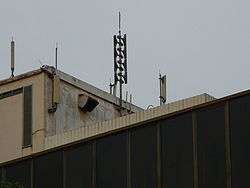Public Warning System (Singapore)
The Public Warning System is a network of civil defense sirens installed by the Singapore Civil Defence Force on over 2,000 strategic points in Singapore to warn Singaporeans of impending dangers, air raids and atomic bomb blasts. Thus far, the siren network has only been used for occasional public awareness drills, monthly noon chimes and for commemorating the island's Total Defence (February 15) and Civil Defence Days (September 15). It was also used to mark a minute's silence nationwide for the passing of former Prime minister Lee Kuan Yew on the evening of 23 March 2015 and on August 1st and 9th, 2020 to mark the first National Day at home. [1]

History
When it was a British colony, Singapore had mechanically-powered air raid sirens over the island, but the system did not work perfectly and was defunct after World War II. Then, in the 1980s, the SCDF planned a network of powerful electrical sirens throughout Singapore to warn the people of natural disasters and air raids. The first 250 of these sirens were completed by Hörmann Warnsysteme GmbH in 1991 and tested in 1992 on certain parts of Singapore, and by now 284 sirens are installed on rooftops of selected buildings or on the ground if there are no buildings.
Types
There are a total of four installation types, they can be installed with:
Standard: Eight horns joined together on the left and right sides of a thin medium length steel pole (for buildings with short, medium or no rooftops). This is the original design from 1992 still used today. Also built as on ground sirens on certain areas of Singapore: Yew Tee Industrial Estate, Sungei Kadut, Adam Road Mid-Sub Power Station, Mandai Air Base, an unknown factory in northern Woodlands and on the compounds of Woodlands Fire Station. This configuration is based on the ECN 1200.
Half-size: Four horns joined together on the left right sides of a thin medium length steel pole (for buildings with medium-high rooftops) or a long steel pole (for buildings with high rooftops). First completed in mid-1990s. This configuration is based on the ECN 600.
Double: Double the horns, but not double the decibels of the signals with sixteen horns as standard type and eight horns for half-size. First completed in late 1990s and installed in early to mid-2000s. This configuration is based on the ECN 2400. Also built as an on ground siren (standard sixteen horn type) on the Assumption English School compound few meters away from the school until it was rebuilt from late 2015 until early 2016 with the siren's current whereabouts unknown.
"Zig-Zag": Four horns joined together in a "zig zag" pattern on both left right sides of a thin short steel pole, this is the default configuration of the ECN 600 completed in 2009 it is currently on the rooftop of Clementi Fire Station.
Sirens attached on appropriate rooftops of buildings can have a custom-made line control unit cabinet (which is white) beside the siren, and to the lower section of on-ground sirens, to eliminate remote control of them from the nearby fire stations turning them into sourcing sirens.
Signals
There are a total of four signals sounded by the sirens, they are:
Alarm signal: Wailing blasts that warn people of a danger or threat and it means for them to move a SCDF air raid shelter. Used only once on the island's Total Defence Day in 2006. (Sounds similar to the 'Attack' signal in the US)
All clear signal: Continuous blasts of a clear sound to allow the people to move out of the shelter if the threat is over. (Sounds similar to the US' Alert signal)
Important Message signal: Pulsating blasts sounded to alert the people of important messages broadcast by Singapore FM radio stations. This is the most used signal as to celebrate Total Defence and Civil Defence Days in Singapore, sounded at 12:05pm on these days. However, from Total Defence Day 2015 and 15 September 2018 onwards, this signal was sounded at 6:20 pm instead of 12:05pm in remembrance of the British's surrender of Singapore in World War II on 15 February 1942 at 6:20 pm.
Testing signal: The test signal is a chime sounded on the 1st day of every month on 12:00PM (GMT+8:00 SGT). Since 2009 this chime has also been used on National Day on August 9 (and since 2011, on the preview show whose date differs every year) to signal the Pledge Moment when Singaporeans recite the Singapore Pledge and sing the National Anthem. In 2009 it was held at 8:22 pm and for 2010 and 2011 it was held at 8:10 pm. 2010's version was known as One Voice 2010 and the time at which it was held (8:10pm) was read as 2010 hrs in the 24-hour clock, coinciding with the year 2010. In 2011 and 2012 it was simply known as the Pledge Moment, and 2012's version was held at about 8pm instead of 8:10pm in previous years. 2020's was on 10:33am & 8:20pm.
Usage in other countries
In 2009, Sircom AG of Germany has thought of using Hörmann's Public Warning System's siren made for the SCDF as a base to make their own sirens, with their default configuration having its horns attached to front and rear of the pole.
See also
- Cell Broadcast
- Emergency population warning
- Emergency Alert System
- Emergency Public Warning System
- Four-minute warning
- CONELRAD
- UK's National Attack Warning System
- Wartime Broadcasting Service
- Protect and Survive
- Transition To War
- Emergency Broadcast System
- Central Government War Headquarters
- Civil Contingencies Secretariat
- RAF Rudloe Manor
- Corsham Computer Centre
- Continuity of government
- Hack Green Secret Nuclear Bunker
- WGU-20
References
- "S'pore-wide public warning system will go off at 10.30am & 8.20pm on Aug 1 for National Day rehearsal". mothership.sg. Retrieved 2020-08-01.